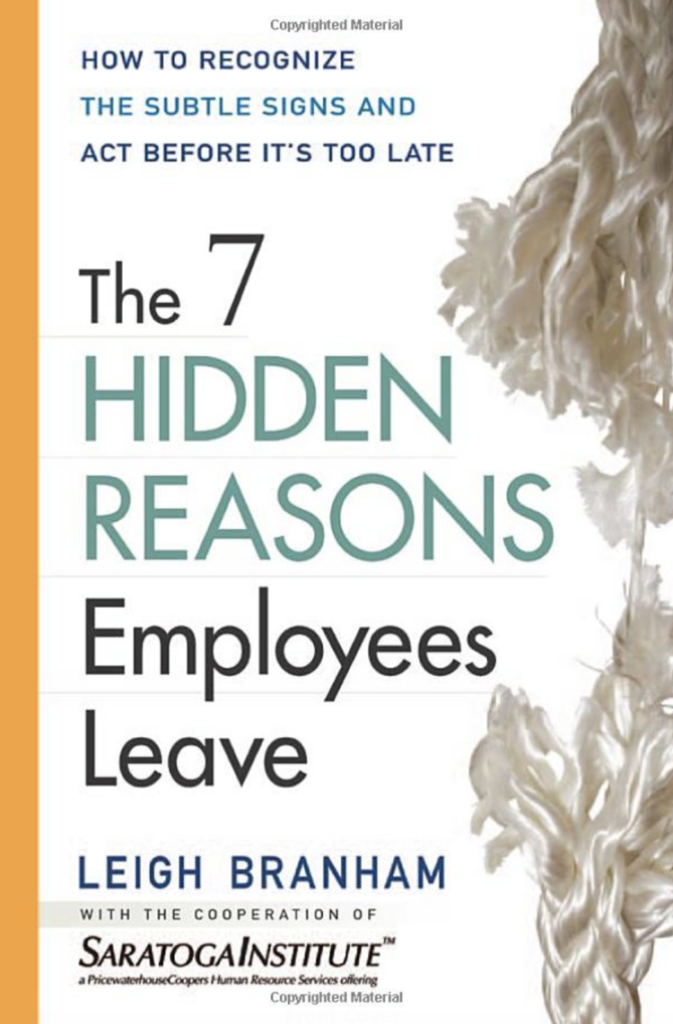BOOK FACTS
- Title: “The 7 Hidden Reasons Employees Leave: How to Recognize the Subtle Signs and Act before It’s Too Late”
- Author: Leigh Branham
- Publisher: AMACOM (American Management Association)
- Copyright: 2005
- No. of Pages: 238
- No. of Chapters: 11
RATING (5 IS A MUST READ – 1 IS LOW INTEREST IN READING)
Readability: 3
Maintains Attention: 5
Applicability of Information: 5
REVIEW
This is Leigh Branham’s second book. His first, Keeping the People Who Keep You in Business: 24 Ways to Hang on to Your Most Valuable Talent, was published in 2001. His most recent work, The 7 Hidden Reasons Employees Leave: How to Recognize the Subtle Signs and Act before It’s too Late, was written in cooperation with the Saratoga Institute, a reputable research firm with an extensive database of thousands of exit interviews and current employee surveys conducted between 1999 and 2003. This survey information, along with a significant collection of business, human resource, and organization development literature, offered the foundation of data for his insightful conclusions. From his research, Mr. Branham was able to ascertain not only why people leave their companies, but also the signs employees exhibit when they disengage, and 54 best practices for addressing and preventing the root causes.
Since this book is full of research findings, the reading doesn’t “flow” as in some books. The reader may want a highlighter or a pen and paper nearby to capture the data that is most pertinent to his/her organization because remembering all the statistics would be a challenge best left to those with photographic memory. However, his purpose in writing this book is not to tell a story, but rather to help business leaders understand why it is important to care about the reasons employees resign, and then to give them research-based direction so they can do something substantial about it.
So why should organization leaders care about this issue? The primary reason is that engaged employees provide the source of greater profitability for an organization. Lower turnover, higher productivity, better safety records, and higher customer ratings are all the results of having an engaged workforce. A secondary reason is that baby boomers will soon be retiring in great numbers, and there will be a talent shortage from now through the year 2012. It will be very difficult to find and hire qualified workers in the years go come, so establishing a culture in which the employees you already have are committed to the organization and desire to stay (i.e., are engaged) will be critical. Business leaders who want their companies to thrive must focus on ways to retain their employees.
SUMMARY OF MAIN POINTS
After the first three chapters in which Branham puts forth the argument of the importance of the topic of the book, the seven chapters that follow have a specific and consistent structure. Each chapter covers the following points:
- The Reason: From his research, Branham compiled the data into seven basic reasons why employees leave their employers. Each chapter focuses on a different reason.
- The Data: He presents the research data that support and validate his selection of the reason as part of the book, as well as the importance and benefits of each reason to business leaders.
- Best Practices: For each reason, an employee may leave, Branham lists several best practices that employers can utilize to prevent such a departure from occurring. Each best practice is explained clearly enough so that the reader can use it as a platform for developing the strategies to be successful.
The seven reasons that Branham proposes in this book are straightforward and make sense. Many of us are able to relate to them from our own employment experiences. The reasons are…
- The Job or Workplace Was Not as Expected: A lack of clarity of organizational expectations and a lack of interest in the expectations of employees will cause friction that may very well initiate disengagement. Job expectations are primarily established during the hiring process. When this “psychological contract” of expectations is broken, new employees are likely to leave within the first six months.
- The Mismatch between Job and Person: Most employees today (and for the last 25 years) feel as though their strengths are not being utilized on a daily basis. Unfortunately, there is a lack of interest and passion on the part of organization leaders to match the right people to the jobs.
- Too Little Coaching and Feedback: When feedback from supervisors and/or managers is insufficient or of poor quality, employees are not able to see the impact of their own efforts to the end results or goals. Companies will often neglect the full preparation and training of supervisory staff because they do not see that people or “soft” skills (including coaching and feedback) as being important.
- Too Few Growth and Advancement Opportunities: When employees do not feel challenged and satisfied in their work, there is a greater likelihood they will leave. Part of this is due to expectation differences of the younger workforce, which requires a “New Contract” between employer and employee in which growth, recognition, and self-satisfaction are greater rewards than promotion.
- Feeling Devalued and Unrecognized: Feeling unappreciated stems from lack of recognition, unfair pay/compensation practices, an organizational focus on the bottom line and not the people, not feeling listened to, lack of tools and resources to do the job, and/or an environment that is poor quality. We all want to feel important, so employees will choose to find companies where they do.
- Stress from Overwork and Work-Life Imbalance: A common problem among businesses today is an ever-increasing workload while the numbers of employees remain the same or even decreases through downsizing. This often comes from a paradigm that employees are costs, rather than assets. When workers are stressed out, they are not productive. Ultimately, they may have to leave for their own individual physical and psychological health.
- Loss of Trust and Confidence in Senior Leaders: Trust and integrity from the top down are what form and strengthen the bonds of employee engagement. Unfortunately, business leaders often make choices that cause their people to distrust them, and loss of confidence in senior leaders is a growing phenomenon.
CALL TO ACTION
All business leaders who want to improve employee engagement and thus reap the cultural and financial benefits should read this book closely and keep it on hand and in mind for all planning meetings, sessions, and retreats. Below are a few steps you can take to utilize this valuable information.
- The organization’s leaders should commit to hiring and retaining talent, with the ultimate goal of becoming an Employer of Choice (see Chapter 11). This won’t work unless everyone in leadership positions is on board.
- Require all leaders, supervisors, and managers within the organization to read The 7 Hidden Reasons Why Employees Leave. Then, hold several discussions about the book to ensure understanding and to build buy-in of its concepts.
- Establish retention goals for the organization, as well as for individual supervisors. Determine the current turnover trends and identify the gaps.
- Work the best practices from The 7 Hidden Reasons Why Employees Leave into the planning process for reaching the selected retention goals.
- Implement the strategies thoughtfully and carefully, allowing the time needed for the involvement of employees. Accept that this will not be a speedy process and be willing to be patient.
- Make sure that you evaluate the effectiveness of the strategies that are put in place within the organization. Continually work to improve the systems, processes, and practices to which you have committed.


